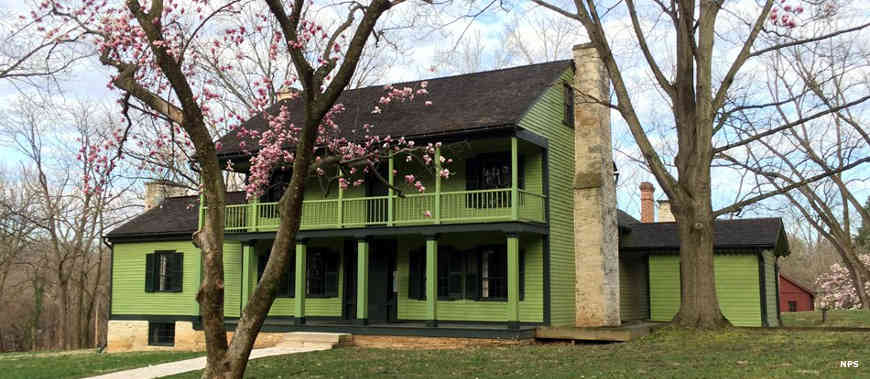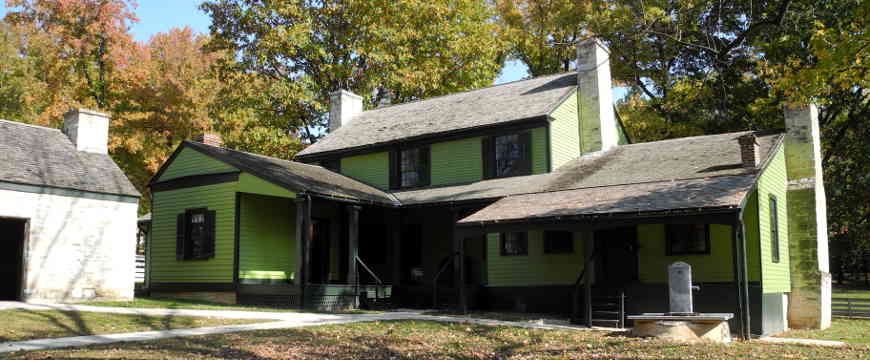Ulysses S. Grant National Historic Site

White Haven

Ulysses S. Grant in the 1870's
The Ulysses S. Grant National Historic Site is a 9.9-acre property located about 10 miles southwest of St. Louis in Grantwood Village. The Site preserves five historic buildings from the heart of what was an 850-acre plantation in the mid-1800's. The plantation was known as White Haven and the wife of Ulysses S. Grant, Julia Dent Grant, was raised there. While at West Point, Grant's roomate was Julia's brother and it was after graduation on a visit to the Dent home that Ulysses met and fell in love with Julia.
After graduating from West Point in 1843, Grant was stationed in St. Louis at the Jefferson Barracks under Colonel Stephen W. Kearny. Grant became engaged to Julia in 1844 and married her in 1848, moving to White Haven himself then: Colonel Dent had given the married couple 80 acres of the plantation as a wedding gift. However, Grant was an enlisted officer in the Union Army. Army officer pay wasn't sufficient to allow his family to travel with him as he was assigned to different posts. That led to Grant resigning his commission in 1854 and returning to the plantation. He managed the plantation for his father-in-law for several years before moving his growing family to Galena, Illinois in 1860 where he worked with his brothers selling leather goods made in their father's tannery. Then the Civil War broke out.
In the years Grant was at White Haven, most work on the plantation was done by slaves. The story of the slaves is a major part of the story of White Haven, including the fact that Grant owned a slave himself. However, he freed that slave in 1859 and during an interview in 1885 (after his death), one Mary Robinson reported, "He always said he wanted to give his wife's slaves their freedom as soon as he was able."
When the Civil War broke out Grant stepped up as a citizen officer in a volunteer Army and rose over the next couple years to become General of the Army. When the war was over he was a bona fide war hero. He turned that into a political career and soon was elected President for two terms. However, his terms in office were marked by corruption in the highest offices of government, including even his first Vice President, Schuyler Colfax. Despite the rampant corruption, none of it was ever traced directly to Grant, it was all placed on the shoulders of his political appointees. After leaving office Grant went on a 2+ year around-the-world tour and returned to the US almost penniless. He continued to engage in various business ventures but as his father had said when he was young, he had no head for business. By 1881, he had to turn his piece of White Haven (in addition to almost everything else he owned) over to William Henry Vanderbilt to pay off a business loan where the funds had been stolen by one of Grant's business partners. Vanderbilt was gracious enough to allow the Grants to continue to live in their home in Manhattan and he eventually donated all the General's war souvenirs to the federal government.
Grant was diagnosed with throat cancer in 1884 and died in 1885. Through those years of his life he had supported his family by selling articles for The Century Magazine. Then he was encouraged to expand those articles and write a memoir of his life. Knowing of his financial difficulties, Congress voted to restore him to the rank of General of the Army with full retirement pay in early 1885. He completed the memoir just days before he died. Mark Twain got involved in the publishing and promotion of that work and it served to make an excellent financial return for the surviving family.
A large portion of the White Haven plantation was eventually bought by Adolphus Busch and he developed his Grant Farm (read: St. Louis Zoo) property there.
The Ulysses S. Grant National Historic Site is open daily, 9 am to 5 pm, except closed on Thanksgiving, Christmas and New Year's Days. Free guided tours of the home are offered every hour or half-hour. Space is limited per tour and tickets are free but they must be acquired at the Visitor Center desk prior to making the tour. There are no fees involved to visit or park (Grant Farm was also free to enter but parking costs $12 (subject to change)).
Ulysses S. Grant National Historic Site is administered by staff at the Jefferson National Expansion Memorial.

The back side of the plantation house
Upper photo and map courtesy of the National Park Service
Lower photo courtesy of Wikipedia userid Kbh3rd, CCA-by-SA 3.0 License